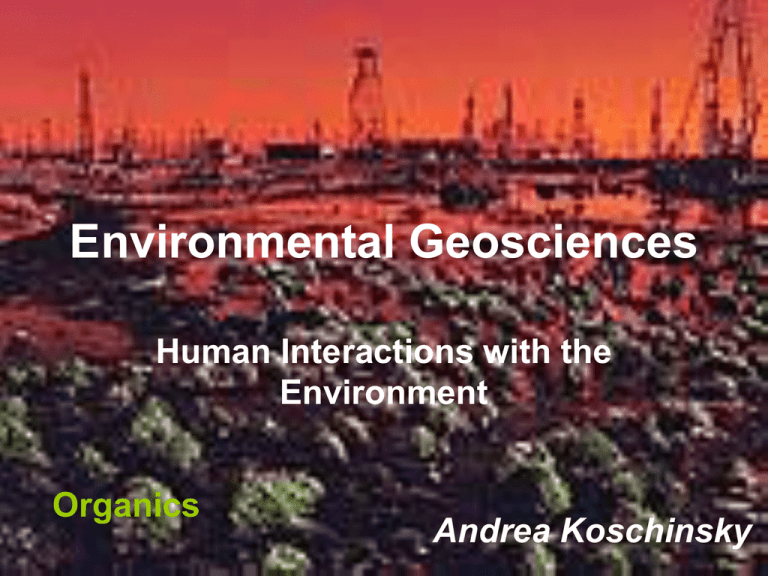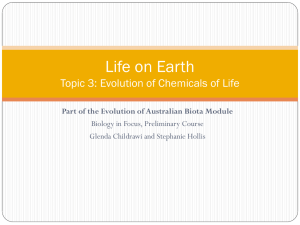EnvGeo Organics 2
advertisement

Environmental Geosciences Human Interactions with the Environment Organics Andrea Koschinsky Distribution and Transformation of Organic Compounds Basic principles of pollutant distribution and transformations. The factors controlling chemodynamics include Henry’s constant, sorption/distribution coefficients, bioconcentration factor, and KOW. Distribution and Transformation of Organic Compounds Materials properties and environmental behavior Transport and Sorption of Organic Compounds Transport and Cycling of Organic Compounds Transport and Cycling of Organic Compounds Transport and Cycling of Organic Compounds Transport and Sorption of Organic Compounds KOA = octanol-air partitioning coefficient PL = vapor pressure of the subcooled liquid TC = condensation temperature Transport and Sorption of Organic Compounds CFCs = Chlorofluorocarbons PCDD = polychlorinated dibenzo-p-dioxin, PCDF = polychlorinated dibenzofuran Transport and Cycling of Organic Compounds Transport and Cycling of Organic Compounds Degradation of Organic Compounds Transformation processes of organic matter: Abiotic and biotic processes Chemical and biological transformation processes control the ultimate fate of hydrocarbons released into the environment. The transformation reactions differ depending on the environmental compartment within which the compounds reside and vary with chemical structure. When hydrocarbons are released to the atmosphere or surface waters, photochemical oxidation, an abiotic process, can occur. In soils and groundwater and surface waters, biologically mediated degradation of hydrocarbons is the most important transformation process. In the absence of light, chemical degradation reactions at Earth surface temperature and pressure are relatively unimportant compared to biologically mediated degradation reactions. Abiotic processes Approximately 25% of the average oil spill on the open ocean evaporates. In the gaseous state, hydrocarbons are readily photooxidized. The dissolved fraction of petroleum also is subject to photo-oxidation. The largest sink for alkanes in the atmosphere is reactions with OH and NO3 radicals (formation of photochemical smog). Mono-aromatic hydrocarbons react only with OH radicals, forming aldehydes, cresols, and in the presence of NO, benzylnitrates. Degradation of Organic Compounds Degradation of Organic Compounds Biotic processes In soils and groundwater, biologically mediated processes dominate. The more water-soluble components of crude oil and petroleum produces are most frequently reported in groundwater downgradients from spills and leaks. These hydrocarbons are biologically reactive and their fate in the subsurface is controlled by microbiological as well as physical and chemical processes. Certain microorganisms are able to degrade petroleum hydrocarbons and use them as a sole source of carbon and energy for growth. Aerobic processes Oxygen is the preferred electron acceptor by microorganisms because of the high-energy yield of these processes. Aerobic degradation of hydrocarbons can occur when indigenous populations of bacteria capable of aerobic degradation of hydrocarbons are supplied with molecular oxygen and nutrients required for cell growth. Studies involving complex mixtures of hydrocarbons have demonstrated that microorganims can degrade most of the hydrocarbons present in gasoline. Degradation of Organic Compounds Degradation of Organic Compounds Summation curves of oxygen consumption in soil (S) contaminated with oil, which was mixed with compost (C) in different ratios Degradation of Organic Compounds Anaerobic processes Anoxic conditions frequently develop in subsurface environments affected by high concentrations of dissolved hydrocarbons because of rapid aerobic biodegradation rates and the limited supply of oxygen. In the absence of oxygen, the oxidized forms of other inorganic species, and some organic species such as humic substances, are used by microorganisms as electron acceptors. The most commonly available electron acceptors in subsurface environments include both solid (such as Fe and Mn oxides) and dissolved (such as nitrate and sulfate) species. In aquifers, as geochemical conditions change, a sequence of reactions occurs, reflecting the ecological succession of progressively less efficient modes of metabolism. Degradation of Organic Compounds Degradation of Pesticides in Soils The entire biocide is bioavailable directly after application. Within a few days there is reversible adsorption to soil particles. Biomineralisation takes place in the dissolved phase, which leads to the mobilisation of adsorbed biocide constituents, where the breakdown continues. Thus, there is a maximum for the amount of bound biocide. Degradation of Organic Compounds Behaviour (transport, transformation) of pesticides in soil Degradation of Organic Compounds Landfill leachate Degradation of Organic Compounds Degradation of Organic Compounds BIODEGRADATION OF PCBs As a result of their very stable properties, PCBs are synthetic compounds that are not readily degraded. The degradation of these compounds entails difficult mechanisms of chemical, biochemical or thermal destruction. Biodegradation, that is, the degradation of compounds by bacteria or other microorganisms, is a slow yet possible method for destroying PCBs in both aerobic and anaerobic environments. It is the only process known to degrade PCBs in soil systems or aquatic environments. The specific processes involved are aerobic oxidative dechlorination or hydrolytic dehalogenation and anaerobic reductive dechlorination. Theoretically, the biological degradation of PCBs should result to give CO2, chlorine and water. This process involves the removal of chlorine from the biphenyl ring followed by cleavage and oxidation of the resulting compound. Persistence of PCBs in the environment increases with the degree of chlorination of the congener. The position of chlorine atoms on the rings also affects the rate of biodegradation A possible pathway for the aerobic oxidative dehalogenation of PCBs Degradation of Organic Compounds Biodegradation of pesticides: DDT Concentration of DDT and degradation products in southern Florida fishes in 1995. Fish at sites 6 and 7 had multiple DDT degradation products; total DDT at all other sites was principally p,p'DDE.








